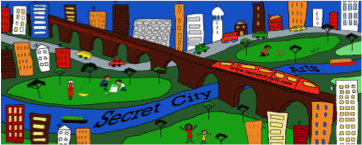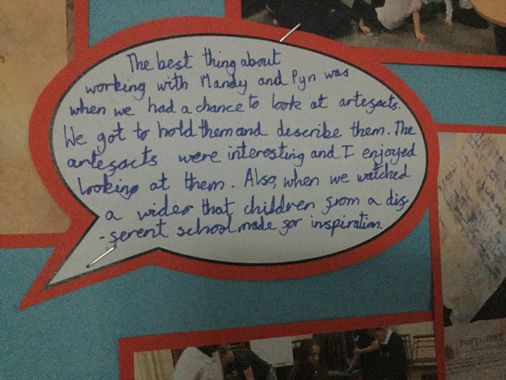What is Generations of Commemoration?




Generations of Commemoration: Re-Presenting the Legacy of the Great War was funded through the Voices of War and Peace AHRC First World War Engagement Centre. It enabled the Birmingham-based community arts organisation Secret City Arts (SCA) to develop their work in helping schoolchildren to understand this long-ago conflict in places where spaces and peoples had undergone considerable transformations in the last hundred years. These transformations posed a challenge for assumptions about the nature of a collective history presented by the centenary commemorations of the Great War and how contemporary communities might engage with it.
In 2015, SCA used Rookery School’s war memorial and the discovery of a 1914-1918 log book as the starting point to work with children to develop their questions about and creative responses to the First World War, in a project titled ‘From Handsworth to Flanders Field’. SCA used print and photo archives to lead the Rookery children in devising and starring in a series of dramatic short films inspired by their discoveries.
Generations of Commemoration builds on this work, and expands it in three key directions. Firstly, it developed the idea of original creative production in film to make use of original archival sources concerned with WW1 and its commemoration. It made use of the resources of the Media Archive for Central England (MACE), which holds over a century of film and video records of life in the Midlands. Secondly, SCA expanded its engagement beyond the specific history of an individual place and worked with several new groups: Old Hill (Oldbury/Sandwell) and St Anne’s (Digbeth), as well as the extracurricular group Action 4 Bullying (A4B) in a series of paired workshops in Sept/Oct 2016. Thirdly, by working with research partners to reflect on and frame SCA creative work, a broader set of questions about memory and history could be addressed.
The project partners
Secret City Arts
SCA is a small arts organisation developing community projects in consultation with adults, children and local community groups. We seek to build awareness, a sense of ownership and a creative response to the secret history, living stories and wild green spaces hidden in the urban environment. Our specialism is to work inclusively, sharing creative skills development to facilitate people and communities to discover, explore and make a creative response to their own locality. We work closely with the local Archive service to bring historical materials out into the community, and create exciting project outcomes in the form of live performance, film, audio work and publications.
Secret City’s practitioners are local history writer Mandy Ross and Pyn Stockman, performance storyteller, oral/living history and drama specialist.
Pyn Stockman: Secret City Arts […] was founded in 2008. Mandy and I met via a CBSO project and decided we wanted to do something. Our first project was ‘Tracing the River Rea’, which I think lies at the heart of some of Secret City’s work, because it was about exploring wild, open green spaces and making a creative response to them.
Mandy Ross: So, we are very much located in the city and making a response to the urban environment and to the hidden stories, the hidden histories that we can discover and make a response to. Working with community groups, adults and children, with schools, with youth groups, with all kinds of different groups and settings.
Pyn Stockman: We have a range of outcomes to our projects. Some of it is about making audio pieces, some of it is about making visual work, and some of it’s about making live performance, creative writing and film.

Mandy Ross: And drawing all those different art forms together, so they’re integrated and firing off from each other.
Pyn Stockman: one of the key things about Secret City is the interplay between the different art forms and how we create projects that explore our own interests, so that we’re very excited about what we do.
Birmingham Centre for Media and Cultural Research (BCMCR)
Paul Long is Professor of Media and Cultural History and Director of Birmingham Centre for Media and Cultural Research (BCMCR). Dr Nick Webber is Associate Director of BCMCR. Both are trained historians and lead the BCMCR research cluster ‘History, Heritage and Archives’. Dr Charlotte Stevens is a Research Assistant at BCMCR, with a background in screen studies and experience in archival retrieval.
In this context the team has worked as media and cultural historians, archive experts and media producers, and collaborated with a variety of public institutions and communities of interest, to draw attention to neglected histories, to respond to the opportunities afforded by new digital technologies, to disseminate archived material, and to interpret it for wide audiences. Through our work we have contributed to an improvement in the understanding and practice of media history, in particular the exploration and archiving of, and engagement with, the popular cultural artefacts which index its lived experience. Most noteworthy have been our contributions to the development of online and offline communities of interest by integrating processes of knowledge exchange into our research, in order to promote co-curation, and discussion about cultural value, memory and collecting.
Voices of War and Peace: the Great War and its Legacy is a First World War Engagement Centre funded by the Arts & Humanities Research Council and in partnership with the Heritage Lottery Fund. The University of Birmingham Centre is a joint initiative across the Midlands with Birmingham City University, University of Wolverhampton and University of Worcester, and further afield with Cardiff University, University of Durham, Manchester Metropolitan University and Newcastle University.
The Engagement Centre is based in the Library of Birmingham and supports a wide range of community engagement activities, connecting academic and public histories of the First World War as part of the commemoration of the War’s centenary.
The Centre covers a broad range of relevant research knowledge that enables it to respond to diverse community interests. This research knowledge ranges from the history of Birmingham, the Black Country and urban and rural Worcestershire to the impact of air power, from the experiences of Belgian refugees to trench warfare, from Quakers and humanitarian relief to battlefield archaeology, and from caring for the casualties of war to the involvement of colonial troops and labour.
Project Background: From Handsworth of Flanders Field
Pyn Stockman: The original World War I project for which we received HLF funding was called ‘From Handsworth to Flanders Field’ and was based around a war memorial that is in Rookery Primary School. That’s where we began with it.
Generations of Commemoration grew out of one of SCA’s previous projects, From Handsworth To Flanders Field. One of the family histories uncovered during Handsworth, that of George Grimmett, provided the basis for the new project: his war service, the war’s effect on his family, and creative responses to the Grimmett story were the narrative basis for historical explorations in Generations of Commemoration.
Documenting SCA’s public history practice as enacted through the Handsworth project is important to understanding the successes of Generations of Commemoration.
Working with Year 6 children at Rookery Primary School, the Handsworth project used local histories to engage schoolchildren in the immediate context of WW1. SCA has an ongoing relationship with this particular school, having worked with classes on projects in the past. Additionally, class teacher and history specialist Annette Whyley is a member of SCA’s board. The WW1 project was inspired (and enabled) by the discovery of the school’s logbooks, which cover the war years, and include names of former students that also appear on the school’s war memorial.
Starting with these names, SCA was guided through archives held by the Library of Birmingham to gain more information about the names identified from the memorial. They identified two individuals, one who was killed in action and one who survived, used civil records (birth/marriage/death records, census data, regimental material) to piece together an idea of these individuals’ lives. Ideally, these men would have lived locally to the school building itself, in order to have an immediate local relevance for the schoolchildren involved in the project. By identifying two men with contrasting experiences, SCA could show different possibilities for wartime outcomes; by limiting the focus to two, SCA could also have a manageable representative sample of WW1 servicemen.
Once the two men were identified, SCA undertook further research at local and national archives (Library of Birmingham; Imperial War Museum).
Pyn Stockman: We began by asking questions with the children, with two Year 6 classes, and uncovering two stories from two of the names on the memorial.
Over six 1.5/2hr sessions, SCA worked with the children to develop creative responses to:
- history clues in the present day environment
- both men’s family life before they joined up
- correspondence about the decision to join up
- correspondence while they were serving
- life on the home front
- school life during the war
- correspondence about the death of George Grimmett
- celebrations for the armistice
- after the war – homecoming, remembrance, at school and at home
The project was initially presented to the children via work with the logbook and school memorial board, with further historical information introduced over the course of the project, as appropriate. Taking time with presenting these historical documents gives children time to develop their own questions about the material and the lives of these historical figures. They were asked to reflect on what they knew (the facts) and what they could imagine or infer based on what they knew from other sources. Out of this came the creative responses, based on information and imagination.